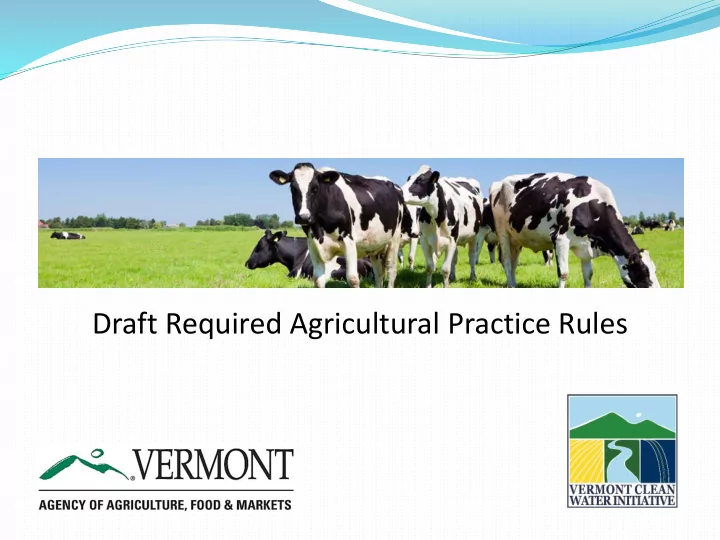

Draft Required Agricultural Practice Rules
What are the RAPs? Act 64 RAPs VAAFM was directed by the Act 64 requires that the revised Legislature to draft the RAPs RAPs include requirements for: pursuant to Act 64, signed small farm certification, into law on June 16, 2015. nutrient storage, soil health, buffer zones, VAAFM has been charged livestock exclusion, and with revising the RAPs by rule nutrient management. on or before July 1, 2016 Tile Drainage Rules for Jan 15, 2018
http://agriculture.vermont.gov/sites/ag/files/PDF/BMP/Act64_VAAFM_Publication_FINAL_9-8-15.pdf
Vermont Clean Water Initiative: All-In WWTF Forest Lands Developed Lands Including Paved Roads Unpaved Roads River Corridors & Floodplains Wetlands Ag Lands
Source: EPA August 2015 Public Meeting Presentation
Source: EPA August 2015 Public Meeting Presentation
USDA NRCS: $45 million over 5 years Increasing Technical and Financial Assistance for all Farms in Vermont Vermont Clean Water Fund: State of Vermont RCPP: $16 million $1.75 Million Proposed for Farms Long Island Sound RCPP: $10 million VACD RCPP: $800,000 Memphremagog RCPP: $600K Proposal
Section 4 Requirements Only For: Certified Small Farm Operations Shall notify Secretary of changes in ownership or land base (including • changes of leased land) within 30 days. §4.10(a)
Section 4 Who must obtain water quality training? • Certified Small Farms • Permitted Medium and Large Farms Training shall provide information regarding topics such as; The prevention of discharges • Land application of manure or nutrients and methods or techniques • used to mitigate runoff Statutory & Regulatory Requirements • Shall obtain 4 hours of approved training at least every 5 years •
Section 5.3 Nutrient Management Planning Proposed Changes: All MFO, LFO, and Certified SFOs (§2.25) shall develop and implement a Nutrient Management Plan (NMP) which meets USDA NRCS Nutrient Management Plan Practice Code 590 All other farming operations All sources of nutrient shall be accounted for when determining recommended application rates of manure. All fields which receive mechanical application of manure and other wastes shall be soil sampled once every 3 years. Plans and records of application rates shall be maintained for 5 years.
Section 5.2 Nutrient, Agricultural Inputs & Waste Storage Field Stacking of Manure Proposed Changes: Prohibited to be stacked in a floodway or in an area subject to flooding • Manure stacks must meet the following setbacks: • 200’ from property lines or domiciles 200’ from surface waters 200’ from private water supplies 200’ from any public water supply 100’ from ditches, swales, diversion or other conveyances Field Stacks can not remain in one location for more than 180 days. 1 in 4 year • storage minimums
Section 5.4 Soil Health Management Recommendations: Cover Crop Requirements Cropland shall be cultivated so that Annual croplands subject to • • average soil loss will be less than or flooding are required to plant equal to the tolerable soil loss (T) for cover crops. Broadcast by September 15 th a particular soil. RUSLE2 Drilled by October 1 Field born gully erosion will be • managed through appropriate BMP.
Section 5.5 Manure & Waste Application Standards Manure may not be spread within 100’ of top of bank of adjacent surface waters: After October 15 or Before April 15th Winter Spreading Ban No Manure or Waste application spread between December 15 and April 1 • Secretary may prohibit between 12/1-12/15 and 4/1-4/30 of any calendar year Emergency exemptions Manure and other wastes shall not be spread when actual or expected weather or field conditions could lead to off site movement of nutrients
Section 5.5 Manure & Waste Application Standards Manure and other wastes shall not be applied when actual or expected weather and/or field conditions are conducive to flooding, runoff, ponding or other off site movement or can be reasonably anticipated to result in flooding, runoff, ponding or other off site movement
Section 5.5 Manure & Waste Application Standards Manure Shall Not be Applied to Fields That: Exceed Soil Test Phosphorus 20 PPM Modified Morgan • Exceed 10% Slope Without vegetated buffers to surface waters of at least 100’ • No manure in buffer Are Saturated with Water • Are frozen and/or snow covered •
Section 5.6 Winter Manure Spreading Exemptions RAPs revise and set new standards for winter manure and wastes spreading • ban. Requirements for requests Standards for approvals Guidelines for manure application
Section 5.7 Buffer Zones & Setbacks Buffer Zone Requirements Surface Water shall be buffered 25’ Intermittent waters, ditches, swales, diversions shall be buffered 10’ Harvesting of Vegetated Buffer is Allowed No spreading manure or wastes in the vegetated buffers Fertilizer may be used per NMP to establish or maintain buffer No Tillage Allowed in Buffer except for establishment or Maintenance Site Specific Variances Variances for vegetated buffers may be considered based on a site specific characteristics
Section 5.8 Animal Mortality Management & Composting Animal mortalities being disposed of on the farm within 48 hours according to the following standards: - Compost - Burial - Render
Section 6.0 Livestock Exclusion Standards Production Area & Immediately Adjacent areas Outside Production Area (Pasture) No Access to Surface Water except: Livestock shall not have access to • At defined crossing surface water outside of production Where prescribed rotational area that: grazing plan exists (3” residual) Have unstable banks of surface In areas approved by Secretary water Adequate vegetative cover shall Areas designated by Secretary be maintained to protect where actual or potential threat banks of surface water exists
Section 10.0 Custom Manure Applicator Certification Custom Manure Applicators (§2.06) shall be certified by the Secretary • Must demonstrate knowledge of RAPs and NRCS 590 standard Must demonstrate competency in methods and techniques to ensure appropriate nutrient application in compliance with environmental standards. Certified custom manure applicators shall train all employees and seasonal • workers in methods and techniques to meet RAP and NRCS 590 standards for nutrient application Certification is valid for 5 years; Shall complete 8 hours of training in each 5 • year period.
Comment To: AGR.RAP@vermont.gov By December 18, 2015 Additional Information: http://agriculture.vermont.gov/water- quality/regulations/rap
Recommend
More recommend